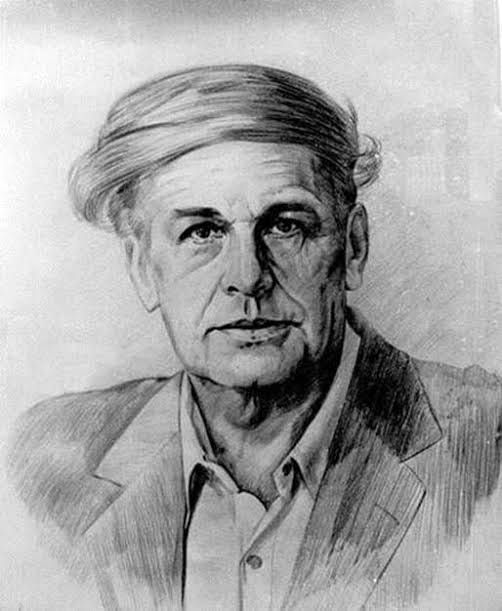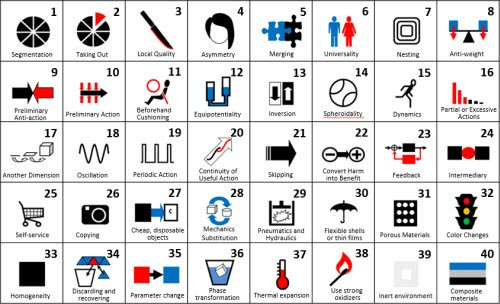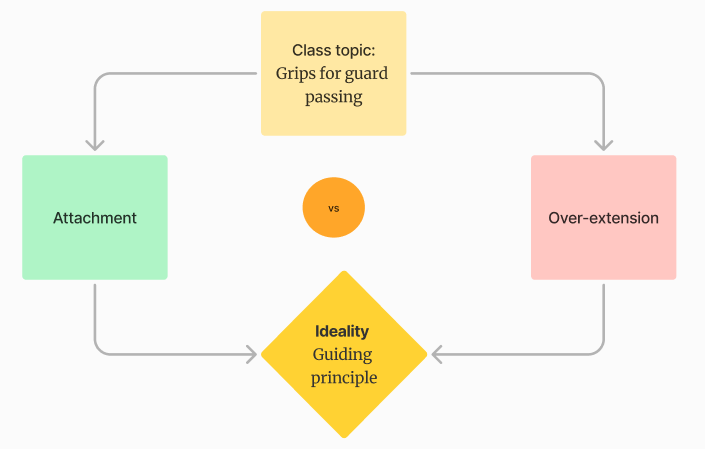How a Soviet engineering framework could help jiu-jitsu practitioners go further faster
How the TRIZ methodology can help us overcome the 'novelty problem' in Brazilian Jiu-Jitsu
“If you can give me the principles, I can derive the rest. If you give me the rest, I might not be able to derive the principles.”
Richard Feynman
Today’s post will examine the ‘Theory of Inventive Problem Solving’, or TRIZ (its Russian acronym), and how it can be used by jiu-jitsu athletes to accelerate their learning.
TRIZ is a versatile and systematic approach to understanding and solving complex problems. Despite being created in Soviet Russia and inspired by the underlying patterns in wartime inventions, this approach is still used today by Ford, NASA, Xerox, Samsung, Intel, and Kodak.
But how can it be used in Brazilian Jiu-Jitsu (BJJ) to help us identify and solve problems faster?
Part 1: The ‘novelty problem’
Brazilian Jiu-Jitsu (BJJ) consists of a mind-boggling amount of variables. This one of the things that makes the sport so addictive to those with an obsessive disposition - and a barrier to entry for anyone else.
If you were to boil down jiu-jitsu on a move-by-move basis, the options you have at your disposal are as infinite as they are paralysing. For those who choose to learn or teach this way, you’ll never escape the ‘novelty problem’.
The novelty problem - Although it’s difficult to trace where this phrase originated, it’s used in various fields to describe a central challenge that exists in innovation and creativity.
Within the context of Brazilian Jiu-Jitsu (BJJ), the novelty problem is what you feel when, in every roll or sparring session, you encounter positions or attacks that always seem unfamiliar or new. Learning move-by-move will only extend this period of unfamiliarity and is a much longer route to mastery.
As I’ve spoken about in previous posts, the novelty problem also exists in any sort of machine learning. For example, in the 80’s when programmers first started training models to play chess, they faced the same difficult choice:
Train the model move by move: An almost impossible task as there are more possible options on a chess board than there are atoms in the known universe.
Train the models by using ‘heuristics’: Heuristics can be explained as ‘general rules’ or things that are ‘true most of the time’.
Using heuristics became the preferred choice as it allowed programmers to give their models general rules to help guide their training while also greatly narrowing the scope of the problem.
In jiu-jitsu, a good heuristic is ‘don’t show your back’. While it’s not true in absolutely every scenario, the value of the heuristic is that it narrows down the number of options a student has and gives them a general rule they can apply to dynamic and evolving situations. (Which jiu-jitsu is full of).
For Danaher and his followers, this has been achieved through teaching by ‘general rules’ (inspired by heuristics); for Gordan Ryan, the idea of organising classes on a general ‘theme’; and for Greg Souders and ecological practitioners, the main driver behind finding ‘invariants’.
“The thing with teaching guard retention is that it’s really difficult to teach because there is an infinite amount of grips. If you were to teach a reaction to every single different grip your partner can make you’ll either forget or you’ll be there forever. Instead, use a ‘common theme’.”
Gordan Ryan
However, the novelty problem poses a further challenge to jiu-jitsu athletes, which goes beyond teaching established moves to students.
When there is a big change in the ‘meta’ of jiu-jitsu, for example, the emergence of position-focused leg locks around 2015, how is it that one gym manages to innovate in a way that is novel enough to give them a lasting competitive advantage over many years—while also adhering to the fundamental principles of jiu-jitsu that allow these new techniques to work at the highest level?
Is there a different way jiu-jitsu athletes can think about technique innovation to create new attacks and strategies while identifying existing restraints?
TRIZ might be the answer. By harnessing the fundamental principles of problem-solving, it created a universal approach to diagnosing and solving complex problems.
Not only did this framework help negate the ‘novelty problem’ in engineering, but it was based on principles so universal that it has been used across several fields—from spacecraft to marketing—providing a formula which allowed engineers to accelerate their innovation.
Part 2: The birth of TRIZ
It all starts in Soviet Russia…
This is Genrich Altshuller.
You’ve probably never heard of him.
His ideas have had an enduring impact on engineering and are still used by the likes of Ford, NASA, Xerox, Samsung, Intel and Kodak. It’s important to note here not just the fact that these are huge organisations but also that they sprawl across many different industries - from rockets to mobile phones. But more on that later.
Born in the Soviet Union in 1926, Altschuller saw everything in his life as a problem that could be solved with invention. However, he didn’t agree with the conventional belief at the time that innovation happened by chance or ‘blood type’. He wanted to find ways to move away from the idea that innovation was some lightning in a bottle that couldn’t be replicated or repeated.
In 1946, Altshuller created his first major invention: a method for escaping from an immobilised submarine without diving gear. This invention was immediately classified as a military secret but also earned him a job as a patent clerk in the Soviet Navy during World War II. This job sent Altshuller further down the innovation rabbit hole - exposing him to numerous patents and technical problems.
But, after a while of sifting through countless patents, Altshuller noticed something. Although all the patents and inventions he assessed had many differences, he began to notice certain underlying patterns, things the inventions had in common.
“Although people who had achieved a great deal in science and technology talked of the inscrutability of creativity, I was not convinced and disbelieved them immediately and without argument.
Why should everything but creativity be open to scrutiny? What kind of process can this be, which, unlike all others, is not subject to control?
What can be more alluring than the discovery of the nature of talented thought and converting this thinking from occasional and fleeting flashes into a powerful and controllable fire of knowledge.”
Genrich Altshuller.
Altshuller was sure he was beginning to identify the ‘mechanics’ of creativity. What if there was an underlying set of principles that could be exploited so that instead of solving problems one at a time, there could be a universal framework that worked across all industries and fields?
Altshuller became convinced that all problems were not different and that failing to recognise that fact came at a significant time cost to the Soviet government. If Altschuller could find a formula to identify these underlying patterns meant distilling a magnitude of problems down to a few core solutions.
Armed with the realisation, Altshuller sent a letter addressed ‘Personally to Comrade Stalin’. In the letter, Altshuller criticised the ‘ignorance’ and ‘chaos’ in innovation in the USSR, saying that time was being wasted on solving the same problems over and over again.
Sadly, his genius was not rewarded. Altshuller was arrested and imprisoned in a Labour camp for several years for ideas that were deemed politically subversive.
But this couldn’t stop Altshuller from being curious about solving what we now refer to as the ‘novelty problem’. Even while incarcerated, Altshuller worked on developing his theory until he came up with the TRIZ framework: a way to harness the fundamental principles of problem-solving so that even new problems could be made familiar.
“I became more and more interested in the mechanics of creativity.”
Genrich Altshuller
Part 3: Theory of Inventive Problem Solving (TRIZ)
TRIZ stands for ‘Theory of Inventive Problem Solving’ (translated from it’s russian acronym).
The framework looks extremely complex at first glance. But let me explain, as the TRIZ methodology has three stages.
Contradictions: The fundamental dilemmas that are central to problems. If I improve X, I worsen Y.
Ideality: A solution that can balance these trade-offs. I improve X without worsening Y.
Inventive principle: The name of the principle that managed to achieve this balance can then be re-purposed to solve many different problems with the same - as well as other - underlying principles.
At each stage, we greatly narrow the number of potential variables. For jiu-jitsu, I believe this is a great way of focusing on the fundamental problems we’re solving and creating universal, repeatable solutions.
1. Contradictions
Altshuller first identified what he called ‘contradictions’, the trade-offs that emerged when trying to create or improve a complex system. They arise when improving one aspect of the system worsens another.
For example, you might want to increase the speed of a car, but by building a more powerful engine, you would add more weight.
This contradiction would be: speed vs weight.
For Altshuller - One of the first uses of this actually came during his imprisonment in a Soviet Gulag. After refusing to sign a confession, Altschuller was placed on an “interrogation conveyor” where he would be questioned all night and, during the day, not allowed to sleep. Quickly, Alsthuller realised he couldn’t survive under those conditions and identified the fundamental problem:
How can I sleep and not sleep at the same time?
The statement itself was a paradox. To survive, he’d need to find a way to do two things simultaneously that were mutually exclusive.
His solution: two pieces of paper were torn from a cigarette package. With a charred match, he drew a pupil on each side of the paper. Altshuller’s roommate spat on the papers and stuck them to Althsuller’s closed eyes. It allowed him to sleep for several days in a row and made his interrogator wonder why he was waking up so fresh each day.
“Most of the work in systems design is figuring out the interactions, or trade-offs, as they were called. The moment you tried to optimise any one part, that choice immediately posed problems for the other parts.”
Richard Rumelt on the contradictions he faced doing conceptual designs of spacecraft, from Good Strategy, Bad Stategy
On the TRIZ chart, there are 39 possible engineering parameters (such as speed and weight) and a matrix that includes 1,482 (39 x 38) possible pairs of contradictions.
This might seem like a lot, but it already greatly narrows the scope of options from the previous infinite problem set.
Speed vs. weight is the fundamental dilemma in this specific engineering problem—but it is also a shared dilemma in many other engineering problems.
Contradictions allow us to unite the micro and the macro of problem-solving and to quickly diagnose what ‘new’ problems have in common with problems we have solved before.
2. Ideality
The next stage in Altshuller's chart looks at how to resolve these contradictions.
‘Ideality’ is the word Altshuller uses when a solution is found that could balance the scales presented by the contradiction. For example, how can we increase the speed of the car without adding weight?
The magic is that speed vs. weight is not a trade-off unique to car engineering. Instead, it spans many different industries and products.
So, whichever solution is found will be equally as applicable across different fields as the contradiction it solves.
TRIZ is about identifying the core of the problem so that you kind find a core, repeatable solution principle.
For Altshuller, when he was transferred to the Varkuta coal mines in another gulag camp, he spent 8 to 10 hours a day developing his TRIZ theory while constantly resolving emergency technical situations in the mines. Nobody believed this young man was visiting the mines for the first time and thought he was lying about his lack of experience. TRIZ allowed him to repurpose his old solutions to new problems.
“The greater the competitive challenge, the greater the need for clever, tight integration of resources and actions.”
Richard Rumelt, Good Strategy, Bad Strategy
3. Inventive principles
However, the process goes a step further in finding a small set of solutions that solve a large set of problems. Once the contradictions had been identified, rather than having 1,482 parallel solutions, Alsthuller looked for the larger inventive principles that could solve multiple contradictions.
For example, one inventive principle that exists in TRIZ, ‘Segmentation,’ which I know is often used in the ecological approach, solves 63 different contradictions.
In total, there are only 40 inventive principles (see above) in TRIZ, which Altshuller believed could be used to solve all engineering contradictions.
For Altshuller - A year after Stalin died, he was released from imprisonment and dedicated his time to creating the TRIZ methodology that we have just run through.
For more details on the full inventive principles, you can read this: TRIZ 40 Principles.
So, it got me thinking: if jiu-jitsu problems could be broken down into their main contradictions, what would be the ‘inventive principles’ of jiu-jitsu?
“Inventing is the resolution of technical contradictions.”
Genrich Altschuller
Part 4: Application to Brazilian Jiu-Jitsu
“Jiu-Jitsu is all about solving problems that are rapidly changing under stress, and that gives you the ability to identify the crux of the problem in front of you, even in a stressful situation and adapt your body and tactics to overcome that problem and to continue overcoming it as the problem itself changes.”
John Danaher
Here is how I apply the framework when I plan my jiu-jitsu classes. I start with a topic or position. I identify the main contradiction (what I’m trying to achieve vs the risk of trying to achieve it) followed by ‘ideality’ - the resolution (solution) of the contradiction.
1. Contradictions and constraints
I taught a few sessions last week and had three students come to me with three different problems. Initially, each seemed unique:
The first had a problem with getting swept from half butterfly whenever they reached for a body lock
The second was getting caught in an omoplata while they were fishing for underhooks
The third was getting arm dragged while they were pinning ankles to pass the guard from standing
When I examined these problems through the TRIZ framework, I realised that while the positions were all different, the fundamental contradiction was the same.
Each of them was trying to pass, or progress their position, but in the process were leaving themselves overextended and vulnerable to sweeps and submissions.
The contradiction was attachment vs over-extension.
This changed my whole approach, as rather than treating symptoms - move-by-move issues my students were facing - identifying this contradiction helped me identify a much larger trade-off my students were facing.
For my students who enjoy ecological games, it gave me an early idea of what would be good constraints/ invariants to start designing games that would allow students to test different forms of grips while working out where they were and weren’t overextended.
2. Ideality - creating goals and objectives
Next, we started to experiment with solutions to this passing dilemma. Many of the best solutions we found in No-Gi were based on two main things to balance the contradiction:
Short grips to test distance - gaining attachment with minimal over-extension
Using footwork to create angles - if we outflanked our opponent, it was harder for them to gain grips to sweep and counter while allowing students to enter with their feet when they saw big openings to the headquarters position.
TRIZ thinking also helped with the class structure. TRIZ helped students realise that every goal we have (linear) will lead to a fundamental conflict: what we want to improve vs the response from the system/our partner (non-linear).
Each position had a fundamental ‘dilemma’ students were trying to solve. The ideal ‘solution’ allowed them to achieve their desired progression or improvement without leaving them open to the worsening factor.
But, for future innovation, there was one more thing to take note of.
3. Inventive principles - for future jiu-jitsu innovation
From the above solutions, shallow attachments and outflanking were broadly the principles we used to resolve this dilemma in guard-passing.
Both of these are also used to solve many other problems in the sport. Could shallow attachments and outflanking make the list of inventive principles for jiu-jitsu?
I hope you enjoyed learning about this framework. I would love to hear your thoughts about how it could be applied in BJJ and other martial arts. What would you say are the principles that you use in jiu-jitsu that could be recorded to solve many other problems? For ecological folks, could contradictions help us determine the best constraints?







Great in-depth read 👏🏾🙏🏾👊🏾( I’m going to try implement the principles of TRIZ methodology this week at training 👌🏾)